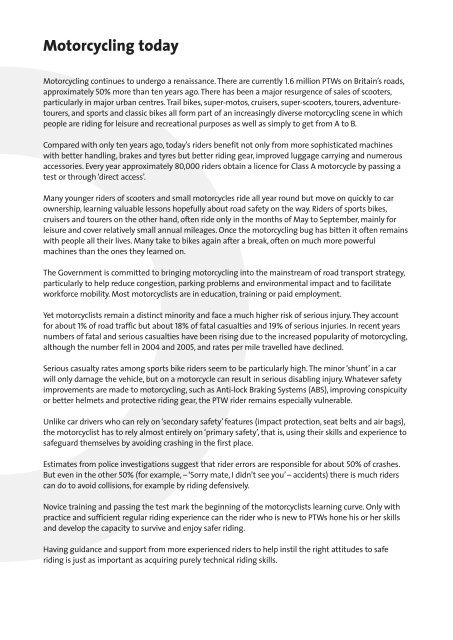Safer Motorcycling Through Work - Network - Motorcycle Action Group
Safer Motorcycling Through Work - Network - Motorcycle Action Group
Safer Motorcycling Through Work - Network - Motorcycle Action Group
You also want an ePaper? Increase the reach of your titles
YUMPU automatically turns print PDFs into web optimized ePapers that Google loves.
<strong>Motorcycling</strong> today<br />
<strong>Motorcycling</strong> continues to undergo a renaissance. There are currently 1.6 million PTWs on Britain’s roads,<br />
approximately 50% more than ten years ago. There has been a major resurgence of sales of scooters,<br />
particularly in major urban centres. Trail bikes, super-motos, cruisers, super-scooters, tourers, adventuretourers,<br />
and sports and classic bikes all form part of an increasingly diverse motorcycling scene in which<br />
people are riding for leisure and recreational purposes as well as simply to get from A to B.<br />
Compared with only ten years ago, today’s riders benefit not only from more sophisticated machines<br />
with better handling, brakes and tyres but better riding gear, improved luggage carrying and numerous<br />
accessories. Every year approximately 80,000 riders obtain a licence for Class A motorcycle by passing a<br />
test or through ‘direct access’.<br />
Many younger riders of scooters and small motorcycles ride all year round but move on quickly to car<br />
ownership, learning valuable lessons hopefully about road safety on the way. Riders of sports bikes,<br />
cruisers and tourers on the other hand, often ride only in the months of May to September, mainly for<br />
leisure and cover relatively small annual mileages. Once the motorcycling bug has bitten it often remains<br />
with people all their lives. Many take to bikes again after a break, often on much more powerful<br />
machines than the ones they learned on.<br />
The Government is committed to bringing motorcycling into the mainstream of road transport strategy,<br />
particularly to help reduce congestion, parking problems and environmental impact and to facilitate<br />
workforce mobility. Most motorcyclists are in education, training or paid employment.<br />
Yet motorcyclists remain a distinct minority and face a much higher risk of serious injury. They account<br />
for about 1% of road traffic but about 18% of fatal casualties and 19% of serious injuries. In recent years<br />
numbers of fatal and serious casualties have been rising due to the increased popularity of motorcycling,<br />
although the number fell in 2004 and 2005, and rates per mile travelled have declined.<br />
Serious casualty rates among sports bike riders seem to be particularly high. The minor ‘shunt’ in a car<br />
will only damage the vehicle, but on a motorcycle can result in serious disabling injury. Whatever safety<br />
improvements are made to motorcycling, such as Anti-lock Braking Systems (ABS), improving conspicuity<br />
or better helmets and protective riding gear, the PTW rider remains especially vulnerable.<br />
Unlike car drivers who can rely on ‘secondary safety’ features (impact protection, seat belts and air bags),<br />
the motorcyclist has to rely almost entirely on ‘primary safety’, that is, using their skills and experience to<br />
safeguard themselves by avoiding crashing in the first place.<br />
Estimates from police investigations suggest that rider errors are responsible for about 50% of crashes.<br />
But even in the other 50% (for example, – ‘Sorry mate, I didn’t see you’ – accidents) there is much riders<br />
can do to avoid collisions, for example by riding defensively.<br />
Novice training and passing the test mark the beginning of the motorcyclists learning curve. Only with<br />
practice and sufficient regular riding experience can the rider who is new to PTWs hone his or her skills<br />
and develop the capacity to survive and enjoy safer riding.<br />
Having guidance and support from more experienced riders to help instil the right attitudes to safe<br />
riding is just as important as acquiring purely technical riding skills.


